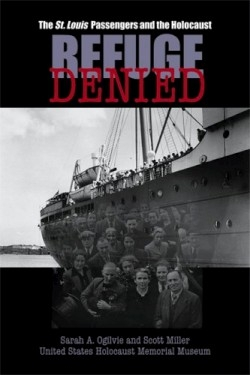Refuge Denied
The St. Louis Passengers and the Holocaust
During the last week of May 1939, the Cuban government refused to grant entry to 937 Jewish refugees fleeing Hitler’s Germany. They were passengers aboard the Hamburg—America Line’s St. Louis. This was three months before the Nazi leader invaded Poland at the start of World War II.
Other boatloads of refugees had found sanctuary in Havana. The authors postulate that a number of factors—greed, political infighting, public agitation against immigration, fascist influences, and anti-Semitism—were the reasons why these Jews were turned back. The German liner then sailed within sight of Miami, where it was barred from entering the United States, despite appeals to President Roosevelt and his wife. U.S. Coast Guard cutters surrounded the vessel to ensure that none of the passengers attempted to swim for shore.
In mid-June, the Jews were forced back across the Atlantic, and found refuge in four western European countries, but only the 288 passengers sent to England were safe from the Nazis’ brutality and persecution.
Although much has been written about that fateful voyage, Ogilvie and Miller have taken the story a substantial step further by revealing what happened to the refugees. Ogilvie is director of the National Institute of Holocaust Education at the United States Holocaust Memorial Museum. Miller is director of the Benjamin and Vladka Meed Registry of Jewish Holocaust Survivors at the Holocaust Memorial Museum.
Having spent nine years travelling and researching, the authors bring to life not just the event, but the people involved. They write that since the purpose of the book “is to trace the passengers’ experiences, one of the hardest parts of writing this was deciding which stories to include.”
One story is that of the Dingfelders, who had owned a butcher shop in Plauen, Germany, and later changed their name to Felder. Bob Felder, a design engineer, died in 1986, but the authors located his widow in her Michigan home in 2001. The Felders had married in 1948 after coming to the United States and eventually had two children.
Ogilvie and Miller have tried—and succeeded—to achieve balance in representing geography, fate, and different ages and genders. Included are men who enlisted in the U.S. Army and helped liberate Europe from the Nazis; the first American soldier released in a prisoner exchange with Korea in 1953; a woman born in Ankara, Turkey; a man who left wartime Europe a second time for Cuba and is buried outside Havana; and two brothers who left the relative safety of England and headed home to Romania and an uncertain future.
The St. Louis tragedy has come to symbolize the world’s indifference to the plight of European Jewry on the eve of World War II. This book offers an understanding of the beginning of the Holocaust and its appalling consequence for Jews.
Reviewed by
George Cohen
Disclosure: This article is not an endorsement, but a review. The publisher of this book provided free copies of the book to have their book reviewed by a professional reviewer. No fee was paid by the publisher for this review. Foreword Reviews only recommends books that we love. Foreword Magazine, Inc. is disclosing this in accordance with the Federal Trade Commission’s 16 CFR, Part 255.

